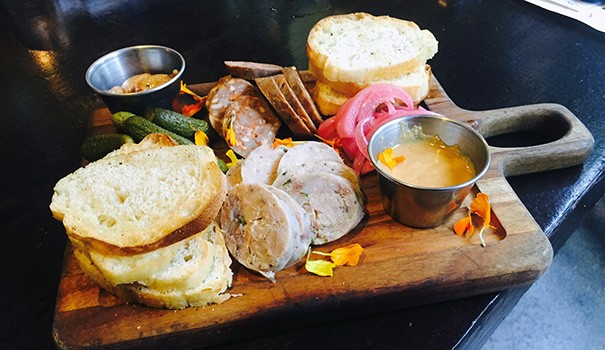
By Frank Sabatini Jr.
The mural that grabs you by the eyeballs when walking into Local Habit says it all.
Since opening as a beer-focused “earth-to-table” restaurant in 2011, and then struggling to cement a firm identity, the Fifth Avenue establishment has undergone a concept change and menu restructuring that could leave you waxing sentimental over your last visit to New Orleans.

Yet for those who have never visited the Big Easy, the drinks and food at Local Habit serve as viable primers.
Under a second set of owners is new executive chef Jimmy Tessier, a graduate of Johnson & Wales and protégé of famed chef Emeril Lagasse. He was also a contestant several years ago on Food Network’s “Chopped.”
Tessier has upheld and enhanced the menu formulated by his Louisiana-born predecessor, Nick Brune, who originally helped launch Local Habit when it became the first restaurant on this village-y block of Hillcrest to offer craft beers and house-cured meats. Those still remain.
But through its recent transition, the restaurant’s continental approach has made way for “swamp water” cocktails, Cajun-marinated fried chicken and puffy beignets served with chicory coffee crème anglaise. Yes, yes and yes.

It has also resulted in an appealing remodel featuring a sidewalk patio, rollup windows, a spruced-up bar, and a 24-foot-long interior mural painted by acclaimed “live artist” Sean Dietrich, whose rabbit-themed fresco dominates a wall at The Rabbit Hole in Normal Heights.
Here, his work summarizes what Tessier describes as a place “where New Orleans cuisine meets California ingredients.” Fantastical images of coastal California verge into all things New Orleans, including water boats doubling as andouille sausages. The longer you stare, the more quirky depictions you discover.
The menu starts off with a board of house-made sausages – onion-chive chicken and decidedly smokier andouille – served with crostini, pickled onions and cornichons. A craft draft or glass of vino from the succinct wine list would strike ideal pairings to the board, but we instead dabbled in the New Orleans cocktail culture with fruity, rum-spiked hurricanes and lime-infused swamp waters mingling vodka and apricot brandy.
Tessier does wonders with pork belly, an appetizer that spans a spectrum of flavors and textures. The pieces were brushed with sweet Creole agave and molasses, which were beautifully contrasted by serrano chili hot sauce. And residing beneath their crispy, flash-fried crusts was the prized mouth-melting meat achieved from slow roasting.

From the entrée list, my companion opted for honey-mustard lamb chops, a Stonehenge-like arrangement of succulent meat and bones encircling truffle-cauliflower puree, baby carrots, and bread pudding containing all the comforts of Thanksgiving dressing — basically the traditional Louisiana “holy trinity” of onions, celery and bell peppers.
Another star ingredient in the dish was bourbon-soaked cherries, which jived lovingly to tender figs and a puddle of rosemary demi gracing the plate. For a neighborhood restaurant, the presentation hit fine-dining standards.
Tessier’s fried Jidori chicken takes on a twist with rice flour, which gives the batter a crispier edge. It isn’t classic Southern-style, but close enough as the fat from the chicken meshes tastefully with the coating, while buttermilk enters into the equation as a choice of sauce on the side. The other sauce options are serrano or Cajun agave.
The chicken undergoes a 48-hour marinade in various chili blends, resulting in the highest heat level named “slap ya mama!” I chose medium, which was safer than expected. No mouth burn, but piquant nonetheless.
 Parked alongside was a dish of kale sautéed in serrano cider vinegar, garlic, and caramelized onions. A bit too acidic, we agreed it was the only off-note to our meal.
Parked alongside was a dish of kale sautéed in serrano cider vinegar, garlic, and caramelized onions. A bit too acidic, we agreed it was the only off-note to our meal.
Despite a fair number of Louisiana favorites in the offing, such as po’boys, shrimp and grits, crawfish linguine, and Creole pizzas (one topped with a stimulating mix of andouille sausage and Cajun chicken), Tessier avoids pigeonholing the menu as exclusively Cajun because a majority of the dishes are given modern spins, oftentimes with locally sourced ingredients.
Right down to the fried-to-order beignets we finished with, Tessier injects a touch of orange juice and zest into the recipe. As with all the savory dishes that came before them, he well proves that solid marriages can be struck between the cuisines of old New Orleans and modern-day California.
—Frank Sabatini Jr. can be reached at [email protected].








